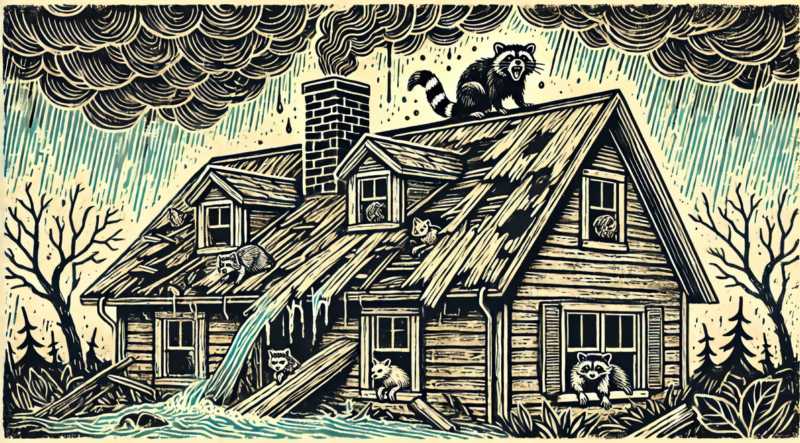Attic Humidity: The Moist Menace
If you think a little moisture in your attic is no big deal, you might as well start planning a welcome party for mold, mildew, and rot. Humidity is like that guest who overstays their welcome and quietly destroys everything in their path.When warm air from your home rises and gets trapped in an improperly ventilated attic, condensation forms. Over time, this moisture seeps into wooden beams and insulation, leading to decay, weakening your roof’s structure, and making your attic an all-you-can-eat buffet for mold spores.
Signs of attic humidity wreaking havoc include:
- Musty smells (because nothing says “dream home” like eau de damp basement)
- Dark spots on wood that weren’t there when you bought the house
- Insulation that feels soggy instead of fluffy
Pest Infestations: Unwanted Tenants
Most roofs aren’t built to accommodate extra residents, but that hasn’t stopped an army of critters from moving in rent-free. Squirrels, raccoons, birds, and even insects see your roof as prime real estate. What starts as a cute little scratching noise in the attic can quickly escalate into a full-scale invasion.Squirrels, for example, have a nasty habit of chewing through roofing materials to make cozy nests. Once inside, they gnaw on everything—wiring, insulation, wooden beams—because apparently, their life goal is to turn your attic into a structural liability.
Then there are raccoons, the roof vandals of the animal kingdom. These masked bandits can pry up shingles with their dexterous little hands and squeeze into tight spaces like furry burglars. And let’s not forget birds, whose nests can clog gutters and trap moisture, accelerating roof decay.
How do you fight back?
- Trim tree branches near your roof to remove their launching pads
- Seal up small openings with mesh or flashing
- Use humane deterrents like decoy predators or spicy repellents (birds hate spice—who knew?)
Air Pollution: The Invisible Saboteur
You probably don’t think of air pollution as something that affects your roof. After all, isn’t it more of a lungs-and-planet problem? Turns out, smog, industrial pollutants, and acidic rain are actively working against your home’s first line of defense.Urban areas are especially susceptible, where airborne contaminants mix with rainwater to form an acidic brew that slowly eats away at roofing materials. Asphalt shingles, in particular, degrade faster in polluted environments, losing their protective granules and becoming brittle.
Metal roofs aren’t immune either—certain pollutants accelerate corrosion, turning a once-sturdy roof into something reminiscent of a rusted-out old truck abandoned in a field.
Signs your roof is suffering from pollution damage:
- Shingles that look more “balding” than weathered
- Unusual discoloration or streaking
- Visible rust on metal roofing
Clogged Gutters: The Waterfall You Didn’t Ask For
Gutters exist for a reason, and it’s not just to collect leaves and small, lost footballs. When functioning properly, they direct water away from your roof and foundation. When clogged, they turn into a slow-motion disaster.Picture this: a heavy rainstorm rolls in. Instead of flowing smoothly through your downspouts, water backs up onto your roof. With nowhere to go, it seeps under your shingles, into your fascia, and—if it’s feeling particularly ambitious—into your walls. Congratulations, you now have a moisture problem that will make your local mold remediation company very happy.
Tell-tale signs of clogged gutters turning against you:
- Water spilling over the sides like a roof-based waterfall
- Sagging or detached gutters (because they’re filled with a swamp’s worth of debris)
- Patches of moss or algae creeping up your roof’s edge
Overhanging Branches: Nature’s Roof Wrecking Crew
Trees are great. They provide shade, boost curb appeal, and make your backyard feel like a little slice of paradise. But if their branches are stretching over your roof like an eager handshake, trouble is brewing.Overhanging branches drop leaves, seeds, and general tree debris straight onto your roof. This organic material traps moisture, which encourages rot, moss growth, and all the things you don’t want near your shingles.
But that’s not even the worst part. During storms, those same branches can scrape against your roof, wearing away protective layers. And if a strong enough wind (or sheer bad luck) sends a branch crashing down, well… hope you have good insurance.
Preventative measures:
- Trim back branches that hover over your roof
- Remove dead or weak limbs before they remove themselves
- Consider a professional tree service if things are looking particularly jungle-like
Shady Shingles: When DIY Repairs Go Wrong
We get it—calling a roofer isn’t always fun. But that YouTube tutorial you watched doesn’t make you a certified roofing expert. A poorly installed patch job can do more harm than good, leading to leaks, uneven weight distribution, or worse, shingles that look like they were arranged by a toddler.Common DIY roofing fails include:
- Misaligned shingles that make your roof look like a bad jigsaw puzzle
- Overuse of sealant, creating water traps instead of waterproofing
- Nails driven in the wrong place, leading to loose shingles or punctures
It’s a Roof-Eat-Roof World
Your roof fights a silent battle every day against forces that don’t announce their attacks. Whether it’s the creeping horror of attic humidity, the chaotic energy of rogue wildlife, or the slow sabotage of air pollution, there’s always something trying to shorten its lifespan.The good news? A little attention goes a long way. Keep your attic ventilated, your gutters clear, your trees trimmed, and—most importantly—know when to call in the experts.
Because at the end of the day, your roof is the one thing standing between you and the elements. And let’s be honest—you probably don’t want to find out what living without one feels like.
Article kindly provided by northernheritageroofing.co.uk


